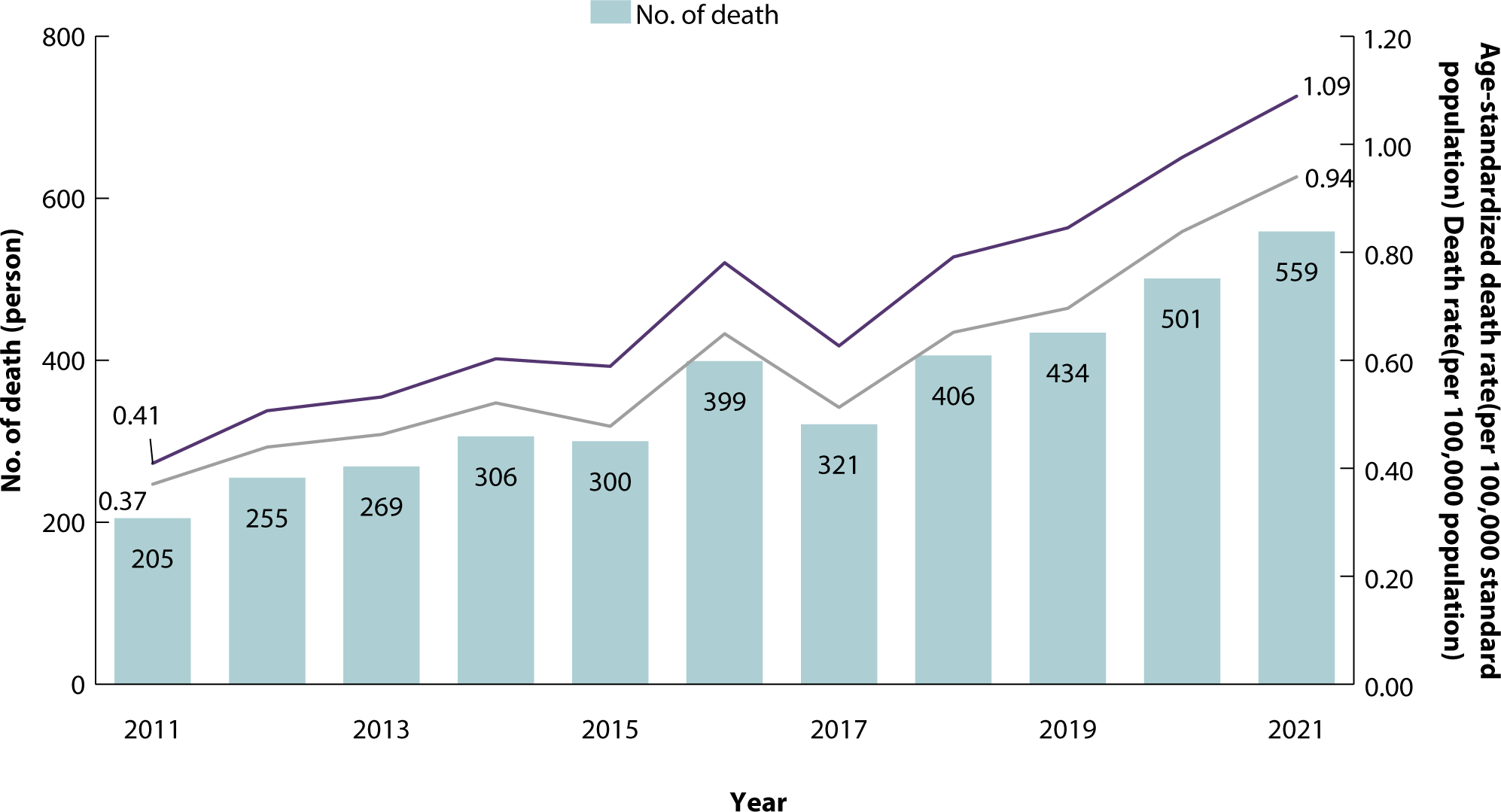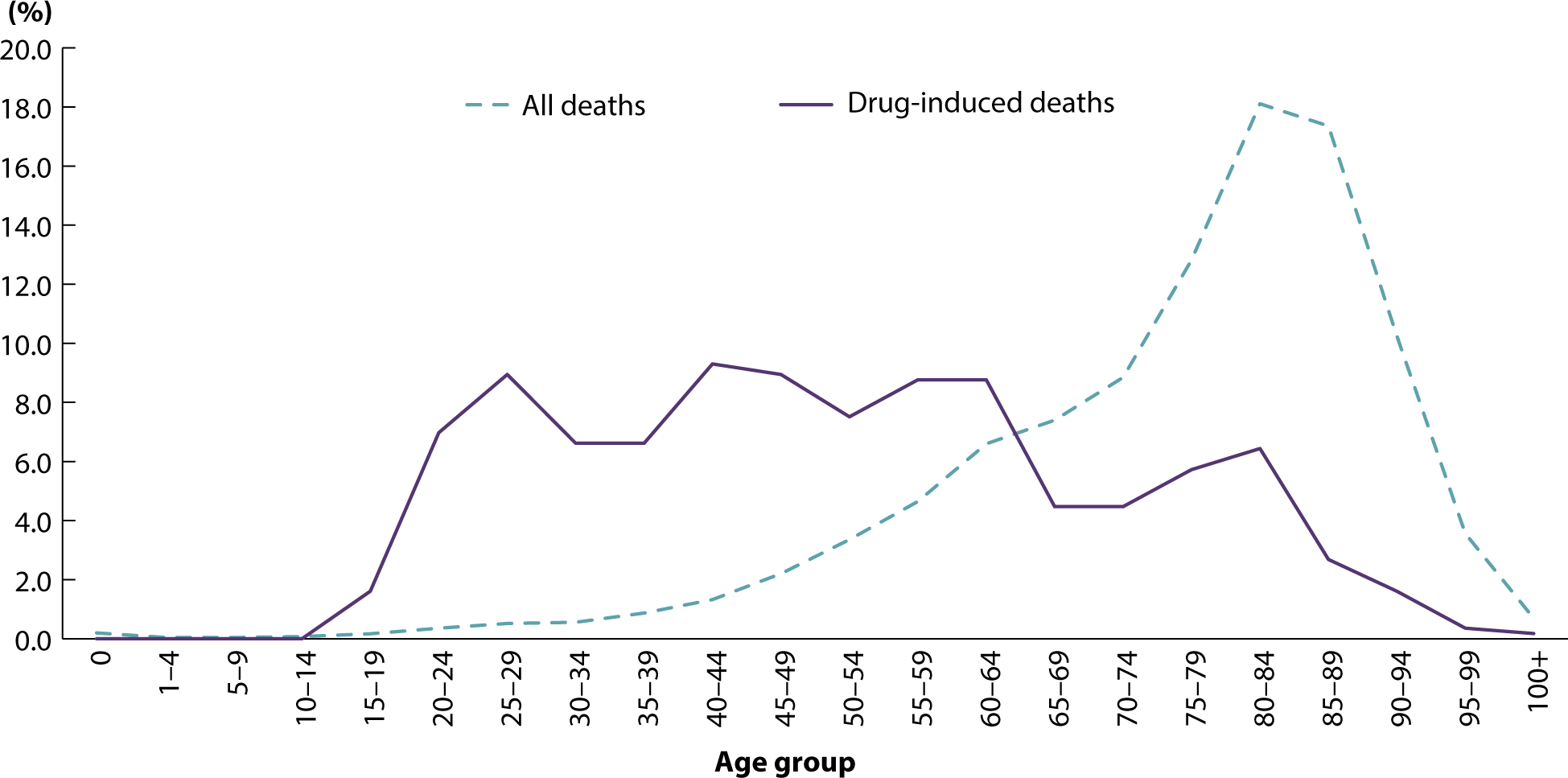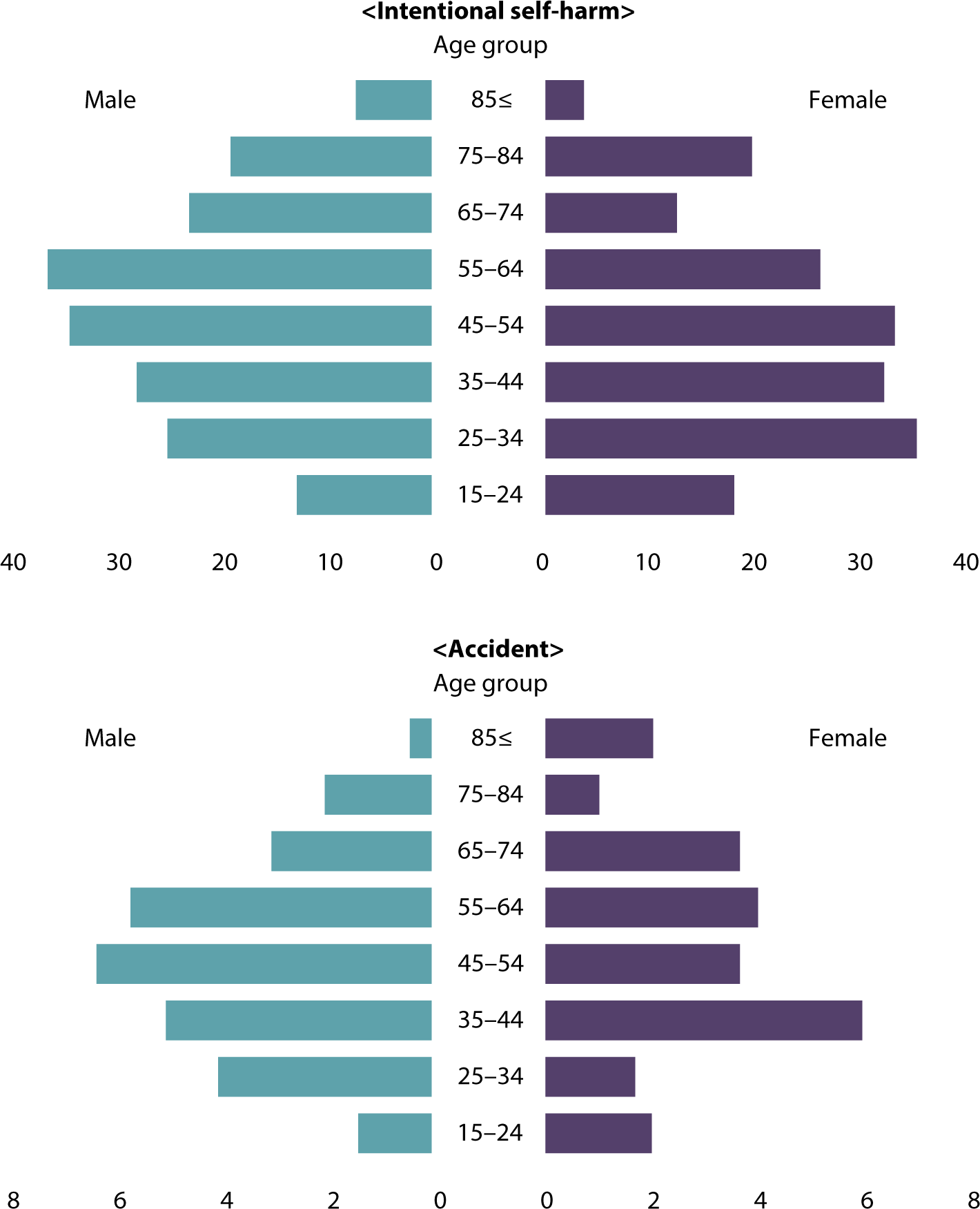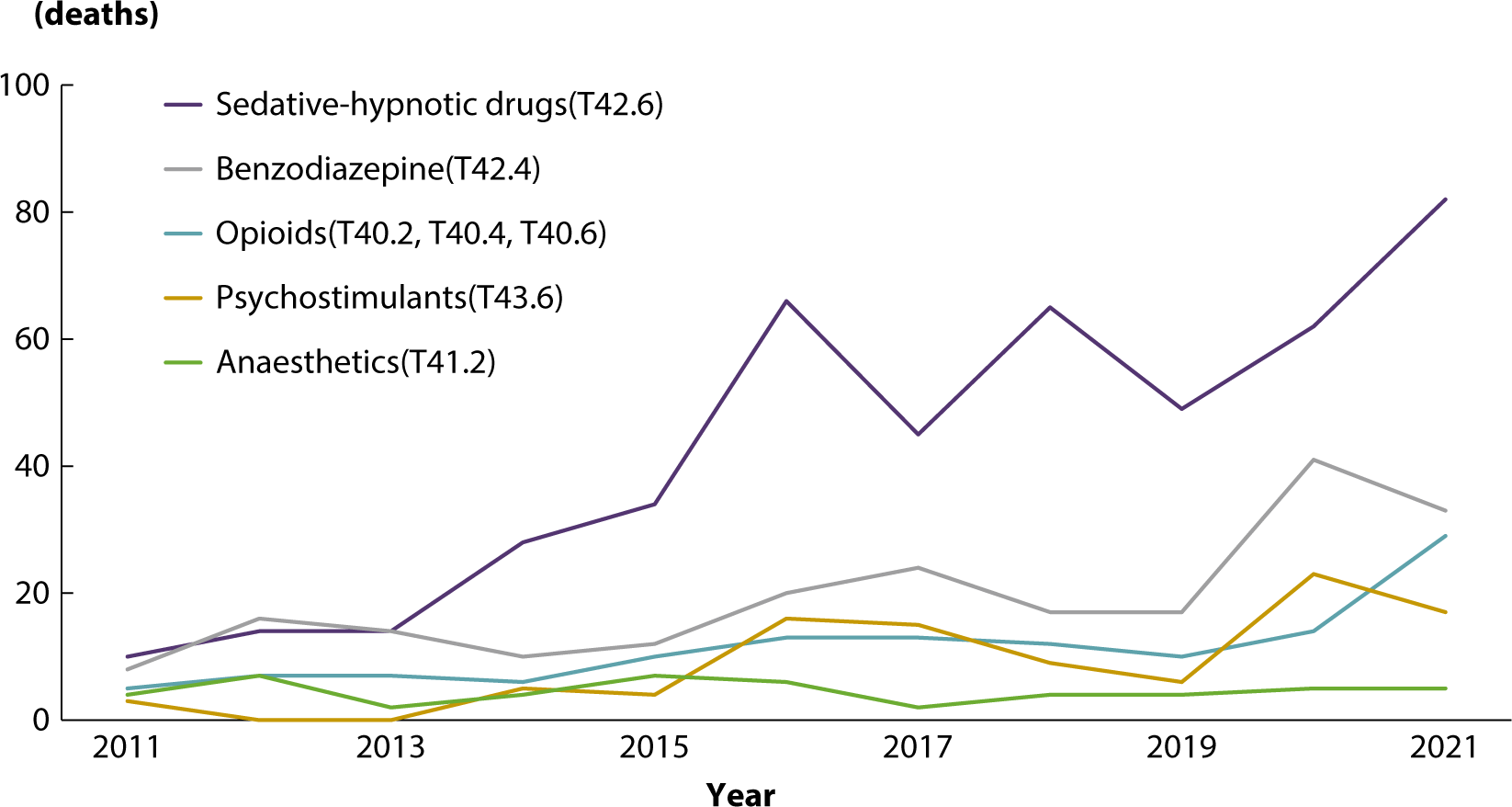Introduction
Deaths caused by drugs are both preventable and avoidable. Furthermore, drug overdose represents a significant issue that requires policy intervention, as it can escalate into larger social problems. Recently, drug abuse has emerged as a major global concern. According to the United States Centers for Disease Control and Prevention, there were 106,699 drug overdose deaths in 2021, marking a sharp increase since 2000. Notably, there has been a significant rise in deaths attributed to opioids such as fentanyl [1,2]. The impact of drugs on mortality involves both direct and indirect factors. Direct causes refer to cases where the primary cause of death is drug-related, as classified by the World Health Organization (WHO) in the International Standard Classification of Diseases (ICD-10). Indirect factors involve drug use increasing the risk of deaths from other causes, such as intentional self-harm, liver disease, hepatitis, and heart disease. The Global Burden of Disease study reported that drug use is responsible for approximately 114,000 indirect deaths and 350,000 direct deaths annually [3].
This study analyzed the characteristics of drug-related deaths, aiming to inform and support drug-related policies. Additionally, it sought to identify risk factors associated with drug-related deaths to aid in the development of strategies to reduce such fatalities. The report specifically focused on the demographic characteristics, types of deaths, and the various drugs involved in drug-induced fatalities.
Methods
This study involved an analysis of public data; therefore, neither approval by the institutional review board nor the obtainment of informed consent was required.
This descriptive study was based on public data from Statistics Korea, and it was described according to the STROBE Statement available from: https://www.strobe-statement.org/.
This study analyzed microdata on cause of death statistics from Statistics Korea spanning from 2011 to 2021 to examine the characteristics of drug-related deaths. The cause of death statistics in Korea are compiled from death certificates. To enhance the accuracy of determining the underlying cause of death, Statistics Korea integrates 22 types of administrative data for each individual. The detailed administrative data includes health insurance information from the National Health Insurance Service, cancer registry data from the National Cancer Center, criminal investigation records and traffic accident investigation data from the National Police Agency, autopsy records from the National Forensic Service, emergency records from the National Emergency Medical Center, among others. Notably, drug-related deaths are reliably documented, reflecting data from police investigations and autopsy reports provided by the National Forensic Service. The ICD-10 code list for causes of death due to drugs is provided in Supplement 1. Deaths due to drugs were categorized by cause of death into disease, accident, intentional self-harm, and homicide, and further analyzed by classifying the drugs involved into opioids, sedatives, and psychotropic agents.
Results
In 2021, there were 559 drug-induced deaths in Korea, marking a 172.7% increase from the 205 deaths recorded in 2011 (Table 1, Fig. 1). The average number of drug-induced deaths per day was 1.5. The mortality rate was 1.1 per 100,000 population, and the age-standardized mortality rate was 1.1 per 100,000 standardized population. Deaths due to drugs steadily increased throughout the study period and predominantly occurred in relatively young age groups (Fig. 2). While the highest percentage of all deaths in 2021 occurred in individuals aged 80−84 (18.1%), a significant proportion of drug-related deaths occurred in those aged 64 or younger.


Compared to 2011, the number of deaths in 2021 increased across all age groups for both men and women, with a notable rise in the younger demographics. Specifically, the mortality rate for men aged 25 to 34 and for women aged 15 to 24 saw significant increases (Supplement 2). Of the deaths caused by drugs in 2021, 75.0% were intentional self-harm and 10.4% were unintended accidents. The number of deaths attributed to intentional self-harm involving drugs has increased since 2011. Over the past three years, the average age at death from drug-related causes has been consistently lower for women than for men (Fig. 3). When categorizing deaths by drug type since 2011, the three most prevalent drugs based on their effects were sedatives and sleeping pills, such as zolpidem and benzodiazepines; psychotropic drugs, including antidepressants and neuroleptics; and a combination of narcotics and psychotropic drugs, notably fentanyl (Supplement 3).

To analyze deaths specifically attributed to designated medical narcotics in Korea, narcotic drugs were categorized according to ICD-10 codes (Supplement 1). In 2021, there were 169 deaths due to medical narcotics, representing a 5.5-fold increase from the 31 deaths recorded in 2011. Although the number of deaths decreased from 127 in 2016 to 89 in 2019, there has been a rapid increase for two consecutive years (Fig. 4). A detailed breakdown of deaths by type of medical narcotic shows that sedative-hypnotic drugs account for the highest number, followed by benzodiazepines and opioids. Notably, the number of deaths associated with sedative-hypnotic drugs, such as zolpidem, and opioids, such as fentanyl, is on the rise (Fig. 5). Men had a higher proportion of deaths involving psychostimulants than women, and women had a higher proportion of deaths involving sedative-hypnotic drugs, general anesthetics, and appetite depressants than men. An analysis of medical narcotics deaths by age between 2019 and 2021 revealed that the risk of death from narcotics varied with age. Specifically, opioids accounted for a high proportion of deaths among individuals aged 25 to 54, benzodiazepines were involved in a large proportion of deaths among those aged 45 to 64, sedative-hypnotic drugs predominated among those aged 55 to 74, and deaths related to general anesthetics were most common among those aged 25 to 34 (Table 2).

Among deaths attributed to medical narcotics, psychostimulants and opioids represented a significant percentage of accidental fatalities. In instances of intentional self-harm, sedative-hypnotic drugs and benzodiazepines were commonly employed. Specifically, sedative-hypnotic drugs constituted 56.7% of drug-related intentional self-harm cases (Supplement 4).
To analyze the risk of death associated with the use of medical narcotics, the number of health insurance claims for narcotics was compared to the number of deaths. For both opioids and psychotropic drugs, the proportion of deaths relative to the number of claims is higher in younger age groups, indicating that the risk of death from narcotic drugs is comparatively high among the young. Specifically, the number of deaths relative to the number of opioid claims in the 25−44 age group represents a higher proportion compared to other age groups (Supplement 5).
Discussion
In 2021, there were 559 drug-induced deaths, marking a 172.7% increase from the 205 deaths recorded in 2011. The rate of drug-induced deaths per 100,000 people rose to 1.1 in 2021, up 153.6% from 0.4 in 2011. Of the drug-induced deaths in 2021, 75.0% were due to intentional self-harm, and 10.4% were accidental. Deaths attributed to medical narcotics reached 169 in 2021, a significant increase, up 5.5 times from 31 in 2011. The most commonly involved drugs in these fatalities were sedative-hypnotic drugs, benzodiazepines, and opioids.
While most deaths occur between the ages of 80 and 84, the majority of drug-related deaths took place in individuals under the age of 64 (Fig. 2). This suggests that deaths due to drugs often result in premature mortality compared to other causes, thereby disproportionately increasing the disease burden. Furthermore, there has been a significant rise in the risk of death among younger age groups over the past decade. Given that 75% of drug-related deaths are due to intentional self-harm (Fig. 3), it is evident that intentional self-harm involving drugs has significantly contributed to the increased mortality rates in this demographic. This trend highlights the emergence of drug-induced intentional self-harm as a pressing social issue.
Deaths due to medical narcotics have increased more rapidly than those due to other drugs (Fig. 4). Gender differences were observed in deaths from medical narcotics: men were more likely to die from drugs with stimulating effects, while women were more likely to die from drugs with sedative effects. The types of medical narcotics associated with the highest mortality rates also varied by age, reflecting the fact that the most commonly prescribed drugs and treatments differ across age groups (Supplement 5). Notably, benzodiazepines were disproportionately involved in deaths among the young age group of 15 to 24 years old (Table 2). Because opioids are often used as painkillers for terminal cancer patients, there are limited medical applications of opioids in younger age groups. However, there are two potential reasons for the relatively high risk of opioid-related deaths among young people. The first is the misuse of narcotic drugs, where death results from intentional misuse without adhering to prescribed dosages or methods of administration. The second involves medication being obtained through illegal distribution or purchase, rather than being prescribed through a legitimate health insurance system. To conduct a thorough analysis, it is essential to prepare big data linking narcotic drug prescriptions to death data.
Among medical narcotics, drugs with sedative effects—including sedative-hypnotic drugs, anesthetics, and benzodiazepines—are frequently used for intentional self-harm (Dataset 1). Therefore, these drugs require special management. When comparing the number of health insurance claims to the number of deaths associated with medical narcotics, the ratio for individuals aged 25−44 was notably high (Table 2). This indicates an elevated risk of death in this younger age group, necessitating targeted management and policies to reduce drug-related deaths.
No previous articles have reported drug-induced death statistics in Korea. As drug addiction becomes an increasingly significant social issue in many countries, including the United States, the need for robust statistics to inform related policies is becoming more apparent. In the United States, the age-standardized drug-induced death rate for the total population increased by 29.4% from 22.8 in 2019 to 29.5 in 2020 [2]. The European Union has developed an estimation model to address the problem of undercounting drug-related deaths [4].
The need for policy support to address drug-related deaths is growing, yet there is a significant shortage of statistical indicators that can determine the extent and risk factors associated with these fatalities. This scarcity of statistical indicators for drug-induced deaths stems from three primary factors.
The first issue is the incompleteness of the criteria used to classify deaths caused by drugs. Typically, the management of drug distribution and prescriptions is governed by the Anatomical Therapeutic Chemical Classification (ATC) codes, which are designated by the Collaborating Center for Pharmaceutical Statistics Methods (WHOCC), an affiliate of the WHO. Each ATC code is structured into five levels: drug application site, drug efficacy, drug characteristics, chemical properties, and individual ingredients. This detailed classification system facilitates the specific categorization of drugs, such as opioid-related drugs and benzodiazepines. However, when classifying causes of death, the ICD-10 from the International Standard Classification System (WHO-FIC), another affiliate of the WHO, is utilized. The data on the number of deaths derived from ICD-10 codes is not without its limitations. Due to inconsistencies in code ranges, deaths caused by drugs other than narcotics are inadvertently included. For instance, the T48.3 code, which denotes poisoning by cough medicine, encompasses drugs other than the medical narcotics dextromethorphan and zipeprol. Nonetheless, the risk of death and addiction is significantly higher with medical narcotics than with other general drugs. Additionally, the T43.6 code, which refers to intoxication by psychostimulants with abuse potential, primarily includes methylphenidate, a legal drug used to treat attention deficit–hyperactivity disorder, and methamphetamine, an illegal substance. The ICD-10 coding system’s limitations in terms of the details of drug classification suggest that there is potential for further subdivision in the upcoming revised ICD-11. Thus, the classification systems for drug prescriptions and causes of death differ significantly, particularly in that the cause-of-death codes do not adequately classify drugs in detail.
The second factor is the scarcity of data regarding drug-induced deaths. While drug prescriptions are well-documented, including details about the recipient, the dosage, and the specific medications prescribed, information about drug-related deaths can typically only be obtained through an autopsy or toxicology testing. Furthermore, elderly individuals often take various medications for multiple conditions, and it is not uncommon for younger people to intentionally consume multiple drugs.
Third, there is a lack of linked data spanning prescriptions, illnesses, and deaths. It is crucial to determine whether drug-related deaths are due to acute or chronic poisoning. Furthermore, the underlying diseases and health status of the deceased should be taken into account to accurately assess the impact of the drug on mortality. Therefore, analyzing data that connects prescriptions, illnesses, and deaths is essential. By examining linked data, it would be possible to empirically ascertain the risk of death associated with a drug by comparing its risk and efficacy against the number of people prescribed the drug or the dosage prescribed.
Because cause-of-death statistics must adhere to the standards set by the WHO, analyses involving multiple drugs or drug efficacy, which are necessary for drug death statistics, are not suitable. Therefore, new, separate statistics are required to accurately identify the characteristics of deaths caused by drugs.
The target population for these statistics is defined as Korean citizens whose deaths are associated with drugs. Determining whether drugs are related to a death is only possible through autopsy results; therefore, the actual population is defined as those cases where drugs were detected in autopsies conducted by the National Forensic Service. To develop new statistics using autopsy data, it is essential to establish standards for classifying drugs. In the statistics for drug-induced deaths among Koreans, the statistical classification (ATC code) used for drug prescription and management does not align with the code that classifies the cause of death (ICD-10). Currently, the ICD-10 does not specify detailed drug types. Therefore, a linkage table between the ICD-11 and ATC codes must be developed. To ensure the stability of time series in this linkage table, ICD-10 codes can be additionally linked to construct statistics using a consistent classification system from the drug prescription stage through to the death stage. By developing statistics that classify autopsy data using both ATC codes and ICD-11 codes, it becomes possible to analyze not only the efficacy and type of drugs but also the risks associated with polypharmacy. With detailed classification of drug types, it would be feasible to construct linked big data that spans drug prescription, disease prevalence, and death.
Data sources for linked big data necessitate the integration of health insurance claim details, autopsy data, and cause-of-death statistics. These linked datasets can serve as empirical evidence for analyzing drug death risks and drug safety. Specifically, when multiple drugs are consumed, it is possible to analyze further that the risk of death may increase due to synergistic effects.
Among many countries, the method Australia uses to compile cause-of-death statistics is similar to that of Korea, making drug-induced death statistics from Australia highly relevant to Korea. Generally, drug-related deaths are prone to underestimation; however, the reliability of these statistics is enhanced in Australia by incorporating the coroner’s approval process, and in Korea by including both autopsy results and police investigations in the statistical compilation [5,6]. Australia has compiled statistics on drugs and opioids and has implemented targeted policies, which have led to a decrease in mortality rates.
Conclusion
As drug prices fall and online transactions on platforms like the dark web and cryptocurrency become more prevalent, making them difficult to trace, the risk of drug-related deaths has increased. This is compounded by a rise in the overseas inflow of drugs. Therefore, statistical indicators that can be used to establish and evaluate related policies are essential. It is anticipated that this study and further in-depth analysis will facilitate the development of future research that will identify population groups at risk for drug use, provide targeted educational support, and establish guidelines, ultimately helping to reduce the risk of premature death due to drugs.

